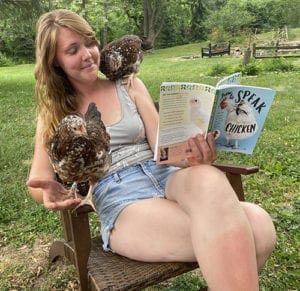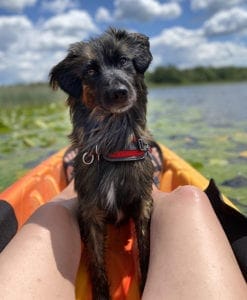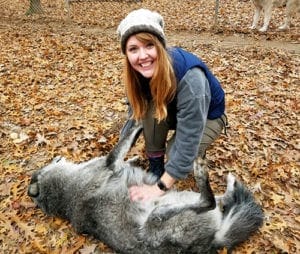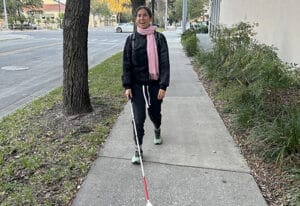
By Guide Dog Mobility Instructor Ashley Nunnelly
In this post, Ashley explains the why and how of clicker training, which is the positive reinforcement method that our guide dog mobility instructors use to work with Leader Dogs in training. If you’re not familiar with a clicker (or marker), it’s a small tool that makes a consistent clicking noise when pressed.
To put it simply, when we use the clicker while training a dog, we’re telling the dog, “THAT’S RIGHT!”
If you read my last blog post (and if you haven’t, you should!), what I attempted to explain was B.F. Skinner’s theory of operant conditioning. Remember—a behavior that has a positive outcome for the learner is likely to be repeated.
Operant conditioning is a method of learning that occurs through rewards and punishments for behavior. Through operant conditioning, an individual makes an association between a particular behavior and a consequence (Skinner, 1938).
Let’s focus on part of that quote: “particular behavior.” This is important, and this is where the marker comes in.
I’m going to give you a hard truth right now—are you ready for it?
Humans are very slow.
 SO SLOW. Let’s use an example to explain the problem. Say you’re training a dog to sit. To help the dog learn with positive reinforcement, you’ve got a supply of treats to give to the dog when they successfully perform the desired behavior. By the time you’ve taken a treat out of your treat pouch and gotten it into your dog’s mouth after a successful sit, they’ve done six other things. They sit, then they look up at you, then they think about the bird that they saw a few bushes back, then maybe they twitched their ears twice, and suddenly—WOW! A treat came to my mouth! How on earth do they know which of those things the treat was for? That’s a lot of guessing. If I were a dog, I would just pick whichever my natural favorite behavior was. Probably thinking about the bird. I like birds. Chickens especially, they’re so cuuuute and they make funny noises and—WHOA, it just happened to me there. It’s pretty easy to lose your learner’s attention.
SO SLOW. Let’s use an example to explain the problem. Say you’re training a dog to sit. To help the dog learn with positive reinforcement, you’ve got a supply of treats to give to the dog when they successfully perform the desired behavior. By the time you’ve taken a treat out of your treat pouch and gotten it into your dog’s mouth after a successful sit, they’ve done six other things. They sit, then they look up at you, then they think about the bird that they saw a few bushes back, then maybe they twitched their ears twice, and suddenly—WOW! A treat came to my mouth! How on earth do they know which of those things the treat was for? That’s a lot of guessing. If I were a dog, I would just pick whichever my natural favorite behavior was. Probably thinking about the bird. I like birds. Chickens especially, they’re so cuuuute and they make funny noises and—WHOA, it just happened to me there. It’s pretty easy to lose your learner’s attention.
So, how do we deal with this? How do we increase the precision of rewarding the dog for the behavior we want? We use the clicker to counteract our human slowness and mark the right behavior. We can use the clicker much faster than we can get the treat to the dog’s mouth. This way, we can mark the sit rather than accidentally marking a different behavior. That tells the dog, “THAT’S RIGHT! Here’s a reinforcer of a treat for performing a sit. Now, do it again!”
This clears up so much confusion for your learner. It takes away the guesswork and the vague parameters of expectation. Also, a click is a very distinctive sound. If every time the dog hears the click, it’s followed with something positive (like a treat), then the sound of the click actually releases a surge of dopamine into their brain—it releases the “happy anticipation.” I GOT IT RIGHT!
Embarrassing story: when I was in 9th grade I had a math tutor that my parents hired to help me with algebra (creative theatre person here. Math was not my forte). He was very handsome. My 14-year-old self had a HUGE crush on this grown man. Every time I got a problem right, he would say, “Perfect.” I wish my typing could convey how he said it, because as I’m typing this my 29-year-old self has butterflies in my stomach and I’m blushing. THAT is positive reinforcement—and that is the happy anticipation that dogs feel before the treat comes. And yes, I ultimately DID get an A in algebra.
When you’re clicker training, timing and observation are essential skills. You have to click the exact millisecond of the behavior that you want.

One time I was playing around with teaching my Pyrenean Shepherd, Gryf, a hearing dog “alert” behavior. It was just for fun and because after going through the Karen Pryor Academy Professionals course (if you haven’t heard of it, Karen Pryor Academy offers certifications in a variety of positive dog training courses) together, Gryf and I have a really solid clicker training language. He helps teach me how to teach other dogs.
My goal behavior was that at the sound of a doorbell, he would repeatedly nudge my leg at my knee with his nose no matter what position I was in until I stood up. So, I was working on teaching him nudge-nudge-nudge-nudge-nudge with a lot of persistence for a long period of time. Because I’m picky, I also decided that I wanted him to nudge me hard enough to make my leg move.
WELL. My first several clicks were too slow, and because Gryf is such a fast learner, I accidentally taught him to very gently nibble my pants seam with only his front teeth. He was CONVINCED that was what I was asking for. Technically, in terms of what I’d just trained, he wasn’t wrong. I had accidentally told him that! And it was very hard to get him out of that mode once I got him into it. If I had been faster and clicked for only his nose touching, or even just when the muscles of his neck moved to jut his chin closer to my knee, then I wouldn’t have clicked myself into that predicament.
So, what does one actually do with a clicker?
The answer is: anything you want! Truly, the possibilities are endless. Let’s talk about two big components of clicker training: capturing a behavior and shaping a behavior.
Capturing: Pick a behavior that your learner does naturally. Let’s say it’s lying down. There are times that your dog does it all on their own. To capture this behavior, you carry a clicker and some yummy treats with you. You casually observe your dog. Your dog yawns, stretches and lies down. CLICK—treat. The dog thinks, “HUH?!” The dog will probably want to guess what on earth made that happen and how can it happen again. A savvy dog that already really knows the clicker game will memorize whatever they were doing at the time of that click and do it again, but most learners will be surprised. Luckily for them, lying down is a behavior that is highly likely to occur again, which means you can click and reinforce with a treat again very soon for “lie down.” After a few repetitions even your least savvy dog will figure out that lie down= click+treat, so they better lie down again really quickly!
Shaping: This is a little more complex. In 1999, Paul Chance defined shaping as “the use of successive approximations to achieve a target behavioral goal.”
WHEW, science talk. In plain English, shaping means slowly raising your criteria of what gets a click so that at each step you get a little closer to your goal. I’ll give you an example “shaping plan” that some incredible Leader Dog instructor apprentices named Emily and Stephanie created.
Our problem: there was a golden retriever in our canine center who, due to a veterinary procedure, had to wear the “cone of shame.” He was totally convinced that he could not lie his head down while wearing the cone and kept his head completely upright while staring at us with indignation in his eyes. We wanted to teach him to relax while wearing the cone. So, we shaped it!
Shaping plan
The plan was to slowly get the golden retriever to accept resting his head on something while wearing the cone, ultimately resting his head all the way on the floor. We started at an easy point for him—just moving his chin in the direction of an instructor’s outstretched hand.
Goal behavior: Golden retriever lies on his mat with his chin on the ground while wearing his cone.
Step 1: Click for putting his chin to someone’s hand.
Step 2: Click for putting the full weight of his chin in the hand.
Step 3: Click for him aiming his chain at a hand when the hand is presented at changing angles, including lowering the hand toward the ground.
Step 4: Click for him aiming his chin for a hand and putting the weight of his chin in the hand.
Step 5: Click for him lying down and resting his chin in the hand for a sustained period of time.
Here, we added the verbal clue “chin” to prompt him to perform the desired behavior.
At this point, he was reliably putting his chin in an instructor’s hand. Now we wanted him to perform the same behavior while touching his chin to the bottom of his cone so that he got used to the feeling of his chin on the cone. To do this, we started offering our hands outside of the cone so that it was the cone touching our hand instead of his chin directly. In the beginning, we encouraged the behavior by smearing a little peanut butter in the bottom inside of his cone.
Step 6: Click for the dog touching his head to the instructor’s hand while the hand is flat on the mat.
Step 7: Click for him lowering his head to mat on the verbal cue and no hands are used.
Step 8: Click for resting his head on the mat for a sustained period of time.
This plan slowly increased the criteria to earn a click. Every step brought the golden retriever closer to lying his chin on the ground with his cone on. We also “lured” him a little bit with the use of peanut butter so that we could create a better opportunity to click for his chin touching the bottom of the cone. We always want to do whatever we can to set the stage for the dog to choose the behavior we’re looking for.
So you see, dear reader, your possibilities are endless. And that is exciting. The wonderful thing about clicker training is that we give the dogs a choice of what they will do next. There is no punishment or fear involved. The dog has autonomy and our clicks and reinforcing treats/petting/praise just guide them. This is so important in the work of a guide dog. They are faced with choices every time they choose to start walking when I or a client gives the command “forward.” The wonderful thing about guide dog work is that I CAN’T force a dog to do it. The dog HAS to choose. The dog has to take those steps and make those choices and find that curb. Every dog that is a guide dog chose to be a guide dog. And my clicks guided those choices for how they do their work.
 Here is a fantastic quote from the Mother of Clicker Training, Karen Pryor, who brought operant conditioning to the pet dog industry:
Here is a fantastic quote from the Mother of Clicker Training, Karen Pryor, who brought operant conditioning to the pet dog industry:
“Then, that memorably powerful look into my eyes told me something more: compared to dogs, wolves are grown-ups. He was not asking for help, head down, forehead wrinkled, as a dog might: ‘Is this right? What do you want?’ Instead, head high, gaze level, he was assessing me, like a poker player: ‘Are you in or out?’ Judging that I was in, he made his move; and we both won.” (p.6)
― Karen Pryor, Reaching the Animal Mind: Clicker Training and What It Teaches Us About All Animals
If you are interested in learning more about clicker training straight from the source, I suggest that you check out Karen Pryor’s books Reaching the Animal Mind and Don’t Shoot the Dog. Those two books are where almost all of my understanding and information about clicker training has come from. Hopefully this post was a good start for those of you who are new or learning clicker trainers!
Read Ashley’s previous post, “Dogs Don’t Speak English.”



